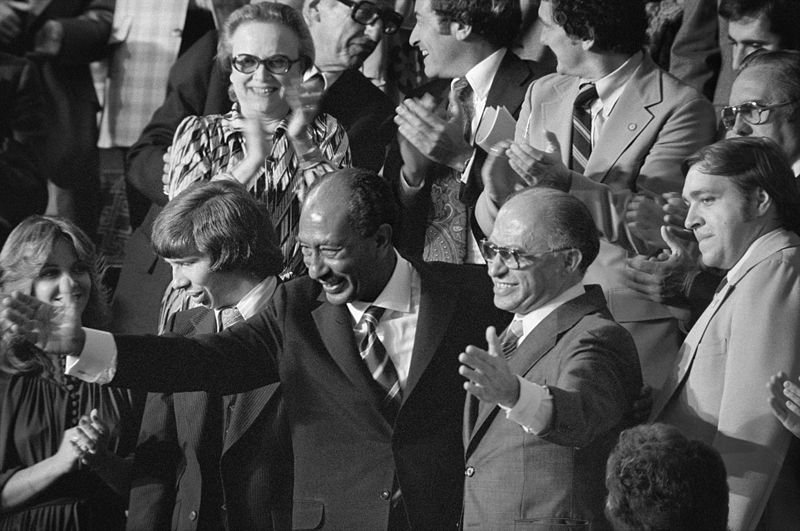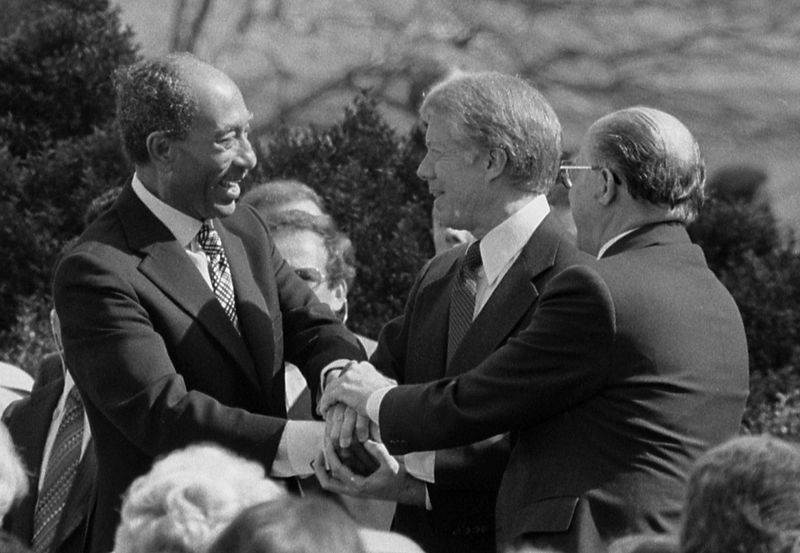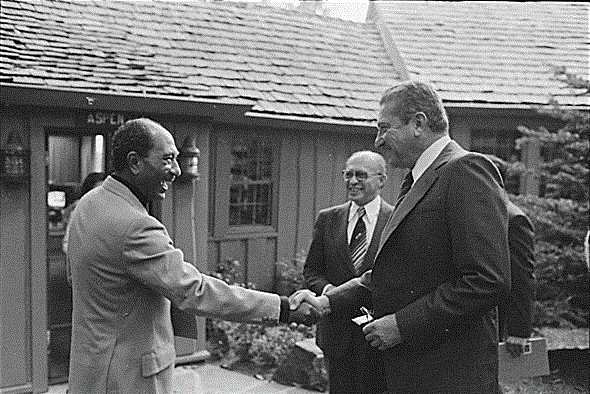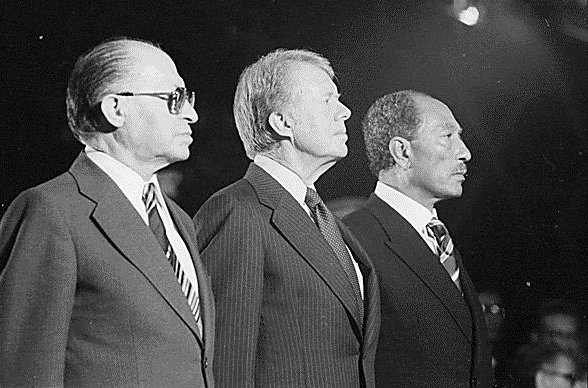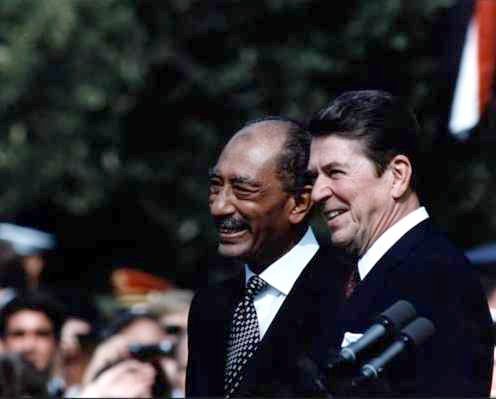<Back to Index>
- 3rd President of Egypt Muhammad Anwar al-Sadat, 1918
PAGE SPONSOR
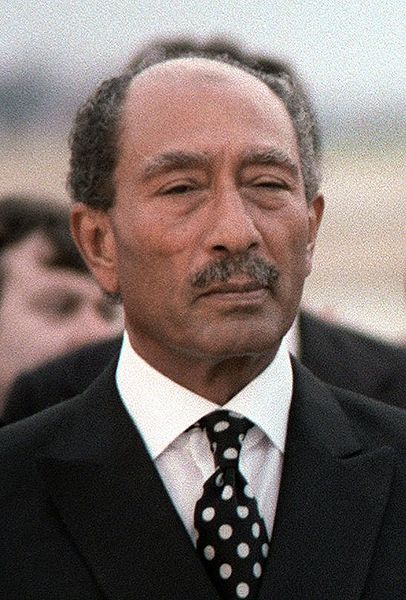
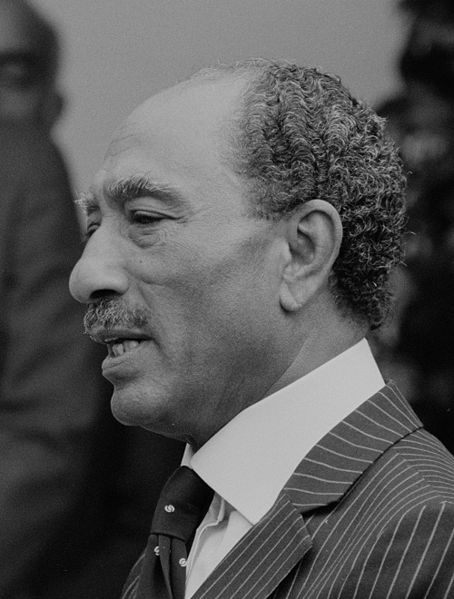
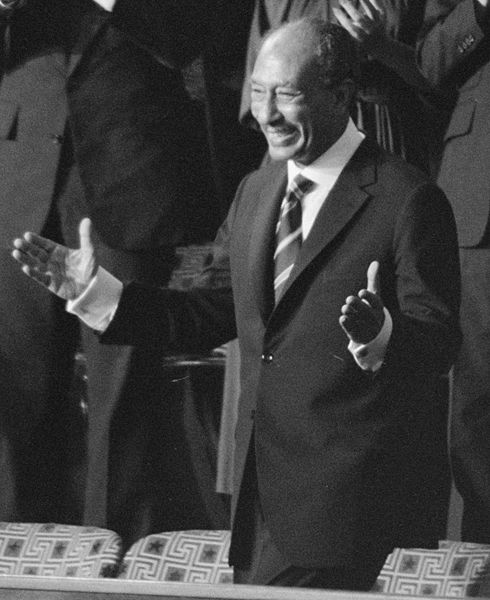
Muhammad Anwar al-Sadat (Arabic: محمد أنور السادات; 25 December 1918 – 6 October 1981) was the third President of Egypt, serving from 15 October 1970 until his assassination by fundamentalist army officers on 6 October 1981. In his eleven years as president he changed Egypt's direction, departing from some of the economic and political principles of Nasserism by re-instituting the multiparty system, and launching the Infitah economic policy.
He was a senior member of the Free Officers group that overthrew the Muhammad Ali Dynasty in the Egyptian Revolution of 1952, and a close confidant of President Gamal Abdel Nasser, whom he succeeded as President in 1970. As president he led Egypt in the October War of 1973 to re-acquire Egyptian territory lost to Israel in the 1967 Six-Day War, making him a hero in Egypt and, for a time, the wider Arab World. Afterwards he engaged in negotiations with Israel, culminating in the Egypt - Israel Peace Treaty. This won him the Nobel Peace Prize but also made him unpopular among some Arabs, resulting in a temporary suspension of Egypt's membership in the Arab League, and eventually his assassination.
Anwar Sadat was born on 25 December 1918 in Mit Abu al-Kum, al-Minufiyah, Egypt, to a poor family, one of 13 brothers and sisters. His father was Nubian Egyptian, and his mother was Nubian Sudanese. He spent his early childhood under the care of his grandmother, who told him stories revolving around resistance to the British occupation and drawing on contemporary history.
During Sadat’s childhood, he admired and was influenced greatly by four individuals. The first of his childhood heroes was Zahran, the alleged hero of the Denshawai incident, who resisted the British occupation in a farmer protest. According to the story, a British soldier was killed, and Zahran was the first Egyptian hanged in retribution. Stories like the Ballad of Zahran introduced Sadat to Egyptian nationalism, a value he held throughout his life. The second individual was Kemal Ataturk, who was the leader of contemporary Turkey. Sadat admired his ability to overthrow the foreign influence and his many social reforms. He also idolized Mahatma Gandhi and his belief of nonviolence when facing injustice. As Egypt was under the occupation of the United Kingdom, Sadat was fascinated by Hitler’s Nazi German army for their quick ability to become a strategic threat to Britain.
He graduated from the Royal Military Academy in Cairo in 1938 and was appointed to the Signal Corps. He entered the army as a second lieutenant and was posted to Sudan (Egypt and Sudan were one country at the time). There, he met Gamal Abdel Nasser, and along with several other junior officers they formed the secret Free Officers Movement committed to freeing Egypt from British domination and royal corruption.
During the Second World War he was imprisoned by the British for his efforts to obtain help from the Axis Powers in expelling the occupying British forces. Along with his fellow Free Officers, Sadat participated in the military coup that launched the Egyptian Revolution of 1952 which overthrew King Farouk I on 23 July of that year. Sadat was assigned to announce the news of the revolution to the Egyptian people over the radio networks.
During the presidency of Gamal Abdel Nasser, Sadat was appointed Minister of State in 1954. In 1959, he assumed the position of Secretary to the National Union. Sadat was the President of the National Assembly (1960 – 1968) and then Vice President and member of the Presidential Council in 1964. He was reappointed as Vice President again in December 1969.
Some
of the major events of the Sadat's presidency were his Corrective
revolution to consolidate power, the break with the Egypt's long time
ally and aid giver the USSR, the 1973 October War with Israel, the Camp David peace treaty with Israel, the "opening up" (or Infitah) of Egypt's economy, and finally his assassination in 1981.
Sadat succeeded Nasser as president after the latter's death in 1970. Sadat's presidency was widely expected to be short lived. Viewing him as having been little more than a puppet of the former president, Nasser's supporters in government settled on Sadat as someone they could manipulate easily. Sadat surprised everyone with a series of astute political moves by which he was able to retain the presidency and emerge as a leader in his own right. On 15 May 1971 Sadat announced his Corrective Revolution, purging the government, political and security establishments of the most ardent Nasserists. Sadat encouraged the emergence of an Islamist movement which had been suppressed by Nasser. Believing Islamists to be socially conservative he gave them "considerable cultural and ideological autonomy" in exchange for political support.
In 1971, three years into the War of Attrition in the Suez Canal zone, Sadat endorsed in a letter the peace proposals of UN negotiator Gunnar Jarring which seemed to lead to a full peace with Israel on
the basis of Israel's withdrawal to its pre-war borders. This peace
initiative failed as neither Israel nor the United States of America
accepted the terms as discussed then. Sadat
likely perceived that Israel's desire to negotiate was directly
correlated to how much of a military threat they perceived from Egypt,
which, after the Six - Day War of
1967, was at an all time low. Israel also viewed the most substantial
part of the Egyptian threat as the presence of Soviet equipment and
personnel (in the thousands at this time). It was for those reasons that
Sadat expelled the Soviet military advisers from Egypt and proceeded to
whip his army into shape for a renewed confrontation with Israel.
During this time, Egypt was suffering greatly from economic problems
caused by the Six - Day War and the Soviet relationship also declined due
to their unreliability and refusal of Sadat’s requests for more military
support.
On 6 October 1973, in conjunction with Hafez al-Assad of Syria, Sadat launched the October War, also known as the Yom Kippur War (and less commonly as the Ramadan War), a surprise attack against the Israeli forces occupying the Egyptian Sinai Peninsula and the Syrian Golan Heights in an attempt to retake the territory captured by Israel six years earlier. The Egyptian and Syrian performance in the initial stages of the war (Operation Badr, also known as The Crossing) astonished both Israel and the Arab World. The most striking achievement was the Egyptian military's advance approximately 15 km into the occupied Sinai Peninsula after penetrating and largely destroying the Bar Lev Line. This line was popularly thought to have been an impregnable defensive chain.
As the war progressed, three divisions of the Israeli army (IDF) led by General Ariel Sharon had crossed the Suez Canal,
trying to encircle first the Egyptian Second Army and when it failed,
the Egyptian Third Army. Prompted by an agreement between the United
States of America and Egypt's Soviet allies, the United Nations Security Council passed Resolution 338 on 22 October 1973, calling for an immediate ceasefire. Although agreed upon, the ceasefire was immediately broken. Alexei Kosygin, the Chairman of the USSR Council of Ministers, cancelled an official meeting with Danish Prime Minister Anker Jørgensen to
travel to Egypt where he tried to persuade Sadat to sign a peace
treaty. During Kosygin's two day long stay it is unknown if he and Sadat
ever met in person. The
IDF then continued their drive to encircle the Egyptian army. The
encirclement was completed on 25 October, three days after the ceasefire
was broken. This development prompted superpower tension, but a second
ceasefire was imposed cooperatively on October 25 to end the war. At the
conclusion of hostilities, Israeli forces were 40 kilometres
(25 mi) from Damascus and 101 kilometres (63 mi) from Cairo.
The initial Egyptian and Syrian victories in the war restored popular morale throughout Egypt and the Arab World and, for many years after, Sadat was known as the "Hero of the Crossing". Israel recognized Egypt as a formidable foe, and Egypt's renewed political significance eventually led to regaining and reopening the Suez Canal through the peace process. His new peace policy led to the conclusion of two agreements on disengagement of forces with the Israeli government. The first of these agreements was signed on 18 January 1974, and the second on September 4, 1975.
One major aspect of Sadat's peace policy was to gain some religious support for his efforts. Already during his visit to the US in October – November 1975, he invited Evangelical pastor Billy Graham for an official visit, which was held few days following Sadat's visit. In addition to cultivating relations with Evangelical Christians in the US, he also built some cooperation with the Vatican. On 8 April 1976, he visited for the first time at the Vatican, and got a message of support from Pope Paul VI regarding achieving peace with Israel, to include a just solution to the Palestinian issue. Sadat, on his part, extended to the Pope a public invitation to visit Cairo.
Sadat also used the media to promote his purposes. In an interview he gave to the Lebanese paper El Hawadeth in early February 1976, he claimed he had secret commitment from the US government to put pressure on the Israeli government for a major withdrawal in Sinai and the Golan Heights. This statement caused some concern to the Israeli government, but Kissinger denied such a promise was ever made.
On November 20, 1977, Sadat became the first Arab leader to visit Israel officially when he met with Israeli Prime Minister Menachem Begin, and spoke before the Knesset in Jerusalem about his views on how to achieve a comprehensive peace to the Arab - Israeli conflict, which included the full implementation of UN Resolutions 242 and 338.
He said during his visit that he hopes "that we can keep the momentum
in Geneva, and may God guide the steps of Premier Begin and Knesset,
because there is a great need for hard and drastic decision."
The Egyptian – Israeli Peace Treaty was signed by Anwar Sadat and Israeli Prime Minister Menachem Begin in Washington, DC, United States, on 26 March 1979, following the Camp David Accords (1978), a series of meetings between Egypt and Israel facilitated by US President Jimmy Carter. Both Sadat and Begin were awarded the Nobel Peace Prize for creating the treaty. In his acceptance speech, Sadat referred to the long awaited peace desired by both Arabs and Israelis.
“Let us put an end to wars, let us reshape life on the solid basis of equity and truth. And it is this call, which reflected the will of the Egyptian people, of the great majority of the Arab and Israeli peoples, and indeed of millions of men, women, and children around the world that you are today honoring. And these hundreds of millions will judge to what extent every responsible leader in the Middle East has responded to the hopes of mankind”
The main features of the agreement were the mutual recognition of each country by the other, the cessation of the state of war that had existed since the 1948 Arab - Israeli War, and the complete withdrawal by Israel of its armed forces and civilians from the rest of the Sinai Peninsula which Israel had captured during the 1967 Six - Day War.
The agreement also provided for the free passage of Israeli ships through the Suez Canal and recognition of the Strait of Tiran and the Gulf of Aqaba as
international waterways. The agreement notably made Egypt the first
Arab country to officially recognize Israel. The peace agreement between
Egypt and Israel has remained in effect since the treaty was signed.
The treaty, which gained wide support among Egyptians, was extremely unpopular in the Arab World and the wider Muslim World. His predecessor Nasser had made Egypt an icon of Arab nationalism, an ideology that appeared to be sidelined by an Egyptian orientation following the 1973 war. By signing the accords, many non - Egyptian Arabs believed Sadat had put Egypt's interests ahead of Arab unity, betraying Nasser's pan - Arabism, and destroyed the vision of a united "Arab front" and elimination of the "Zionist Entity". However, Sadat realized early on that peace is the solution. Sadat's shift towards a strategic relationship with the US was also seen as a betrayal by many Arabs. In the United States his peace moves gained him popularity among some Evangelical circles. He was awarded the Prince of Peace Award by Pat Robertson.
In 1979, the Arab League expelled Egypt in the wake of the Egyptian – Israel peace agreement, and the League moved its headquarters from Cairo to Tunis.
Arab League member states believed in the elimination of the "Zionist
Entity" and Israel at that time. It was not until 1989 that the League
re-admitted Egypt as a member and returned its headquarters to Cairo. As
part of the peace deal, Israel withdrew from the Sinai peninsula in phases, returning the entire area to Egypt on 25 April 1982.
Before the Islamic revolution of Iran in 1979, the relationship between Cairo and Tehran was so friendly that the Shah of Iran (Persia), Mohammad Reza Pahlavi, called Sadat his "dear brother". The Shah's first wife was Princess Fawzia of Egypt. She was the eldest daughter of Sultan Fuad I of Egypt and Sudan (later King Fuad I) and his second wife Nazli Sabri. After
his overthrow, the deposed Shah spent the last days of his life in
exile in Egypt. When the Shah died, Sadat ordered that he be given a state funeral and be interred at the Al-Rifa'i Mosque in Cairo, the resting place of Egyptian Khedive Isma'il Pasha, his mother Khushyar Hanim, and numerous other members of the royal family of Egypt and Sudan.
The last years of Sadat's presidency were marked by turmoil and there were several allegations of corruption against him and his family. It has been said that he was assassinated "at the peak" of his unpopularity. In January 1977, a series of 'Bread Riots' protested Sadat's economic liberalization and specifically a government decree lifting price controls on basic necessities like bread. The riots lasted for two days and included hundreds of thousands in Cairo. 120 buses and hundreds of buildings were destroyed in Cairo alone. The riots ended with the deployment of the army and the re-institution of the subsidies / price controls.
Earlier in his reign Islamists had benefited from the `rectification revolution` and the release from prison of activists jailed under Nasser but Sadat's Sinai treaty with Israel enraged Islamists, particularly the radical Egyptian Islamic Jihad. According to interviews and information gathered by journalist Lawrence Wright, the group was recruiting military officers and accumulating weapons, waiting for the right moment to launch "a complete overthrow of the existing order" in Egypt. Chief strategist of El-Jihad was Abbud al-Zumar, a colonel in the military intelligence whose "plan was to kill the main leaders of the country, capture the headquarters of the army and State Security, the telephone exchange building, and of course the radio and television building, where news of the Islamic revolution would then be broadcast, unleashing - he expected - a popular uprising against secular authority all over the country."
In February 1981, Egyptian authorities were alerted to El-Jihad's plan by the arrest of an operative carrying crucial information. In September, Sadat ordered a highly unpopular roundup of more than 1500 people, including many Jihad members, but also the Coptic Pope and other Coptic clergy, intellectuals and activists of all ideological stripes. All non - government press was banned as well. The round up missed a Jihad cell in the military led by Lieutenant Khalid Islambouli, who succeeded in assassinating Anwar Sadat that October.
According to Tala'at Qasim, ex-head of the Gama'a Islamiyya interviewed in Middle East Report, it was not Islamic Jihad but the Islamic Group (al-Gama'a al-Islamiyya)
that organized the assassination and recruited the assassin
(Islambouli). Members of the Group's 'Maglis el-Shura' ('Consultative
Council') – headed by the famed 'blind shaykh' – were arrested two weeks
before the killing, but they did not disclose the existing plans and
Islambouli succeeded in assassinating Sadat.
On 6 October 1981, Sadat was assassinated during the annual victory parade held in Cairo to celebrate Egypt's crossing of the Suez Canal. In addition to Sadat, eleven others were killed, including the Cuban ambassador, an Omani general, and a Coptic Orthodox bishop. Twenty - eight were wounded, including Vice President Hosni Mubarak, Irish Defence Minister James Tully, and four US military liaison officers. The assassination squad was led by Lieutenant Khalid Islambouli after a fatwā approving the assassination had been obtained from Omar Abdel - Rahman. Islambouli was tried, found guilty, sentenced to death, and executed in April 1982.
Sadat was succeeded by his vice president Hosni Mubarak, whose hand was injured during the attack. Sadat's funeral was attended by a record number of dignitaries from around the world, including a rare simultaneous attendance by three former US presidents: Gerald Ford, Jimmy Carter and Richard Nixon. Sudan's President Gaafar Nimeiry was the only Arab head of state to attend the funeral. Only 3 of 24 states in the Arab League – Oman, Somalia and Sudan – sent representatives at all. Sadat was buried in the unknown soldier memorial in Cairo, across the street from the stand where he was assassinated.
Over three hundred Islamic radicals were indicted in the trial of assassin Khalid Islambouli, including Ayman al-Zawahiri, Omar Abdel - Rahman and Abd al-Hamid Kishk. The trial was covered by the international press and Zawahiri's knowledge of English made him the de facto spokesman for the defendants. Zawahiri was released from prison in 1984. His brother Mohammed al-Zawahri was imprisoned from 2000 until 17 March 2011, and then re-arrested on 20 March 2011. Abboud al-Zomor and Tareq al-Zomor, two Islamic Jihad leaders imprisoned in connection with the assassination, were released on 11 March 2011.
Despite these facts, the nephew of the late president, Talaat al-Sadat, claimed that the assassination was an international conspiracy. On 31 October 2006, he was sentenced to a year in prison for defaming Egypt's
armed forces, less than a month after he gave the interview accusing
Egyptian generals of masterminding his uncle's assassination. In an
interview with a Saudi television channel, he also claimed both the
United States and Israel were involved: "No one from the special
personal protection group of the late president fired a single shot
during the killing, and not one of them has been put on trial," he said.
Sadat was married twice. He was first married to Ehsan Madi at age 22, and divorced her several years later, just 17 days after the birth of their third daughter, Camelia. He then married Jehan Raouf (later known as Jehan Sadat), who was only 15 years and 9 months at the time, on 29 May 1949. They had one son, Gamal, and three daughters: Lobna, Noha and Jehan (named after her mother). It was Gamal who represented his father when he was presented, posthumously, with the Presidential Medal of Freedom in 1984 by U.S. President Ronald Reagan. Jehan Sadat was the 2001 recipient of the Pearl S. Buck Award.
Anwar Sadat's autobiography, In Search of Identity, was published in the US in 1977. Mrs. Sadat was an Associate Resident Scholar at the University of Maryland where
The Anwar Sadat Chair for Development and Peace was established and
fully endowed in 1997 to honor her husband's legacy. A nephew, Talaat Sadat, was imprisoned in October 2006 for accusing the Egyptian military of complicity in his uncle's assassination.
In 1983, Sadat, a miniseries based on the life of Anwar Sadat, aired on US television with Oscar winning actor Louis Gossett, Jr. in the title role. The film was promptly banned by the Egyptian government, as were all other movies produced and distributed by Columbia Pictures, over allegations of historical inaccuracies. A civil lawsuit was brought by Egypt's artists' and film unions against Columbia Pictures and the film's directors, producers and scriptwriters before a court in Cairo, but was dismissed; the court held that "the distortions and the slanders found in the film took place outside the country," so that "the crimes were not within the Egyptian courts' jurisdiction."
Western authors attributed the film's poor reception to racism — Gossett being African American — in the Egyptian government or Egypt in general. Either way, one Western source wrote that Sadat's portrayal by Gossett "bothered race conscious Egyptians and wouldn't have pleased [the deceased] Sadat." – The two - part series earned Gossett an Emmy nomination in the United States. The first Egyptian depiction of Sadat's life came in 2001, when Ayyam El Sadat (English: Days of Sadat) was released in Egyptian cinemas. This movie, by contrast, was a major success in Egypt, and was hailed as Ahmad Zaki's greatest performance to date.
The BBC also produced a film on Sadat called "Why Was Cairo Calm?". Film director and blogger Adam Curtis summarizes
the documentary: "It tells the story of Sadat's presidency - and how
the American TV networks created a fantasy vision of him as a wise
democratic leader who had opened up the Egyptian economy to the free
market, and was loved by his people for making peace for Israel. As the
film shows - this was a complete illusion."
